Cutting Edge
Realizing a Better Future through Sony’s Imaging and Sensing Technology
Oct 15, 2020
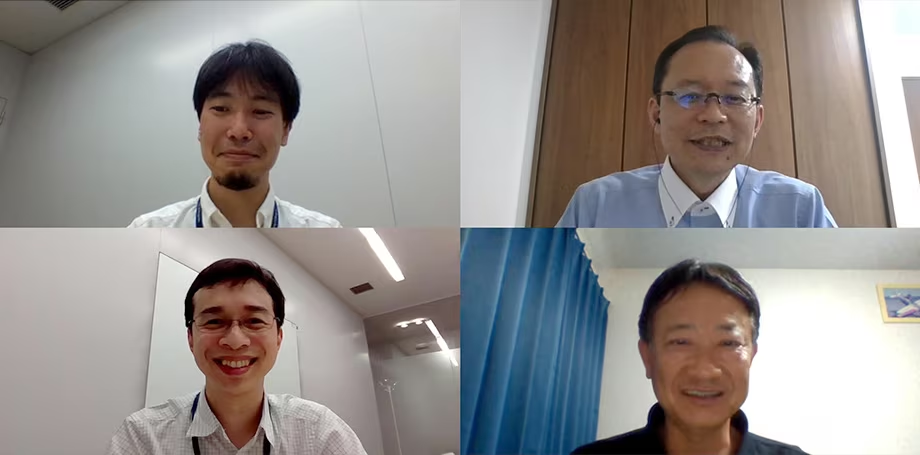
With megatrends in society shifting from "mobile" to "mobility," Sony’s imaging and sensing technology is set to become even more relevant in the future. After releasing the world’s first intelligent vision sensors with AI processing functionality in May 2020, Sony continues to expand its solution business using image and sensing technologies. We interviewed Shimizu, who leads the Imaging & Sensing Solution (I&SS) business, Umebayashi, who contributed significantly to the development of the stacked CMOS image sensor, and two employees in charge of developing automotive image sensors and asked them about the future that they are trying to realize.
Profile
-
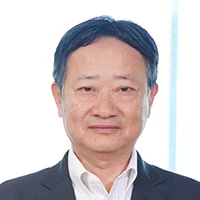
Terushi Shimizu
Representative Director,
President and CEO
Sony Semiconductor
Solutions Corporation
Senior EVP, Officer in charge of Imaging & Sensing Solutions Business, Sony Corporation
Also serves as Representative Director and President of Sony Semiconductor Manufacturing, which is responsible for development and manufacturing of semiconductor and Sony LSI Design, which is responsible for design of semiconductor. -
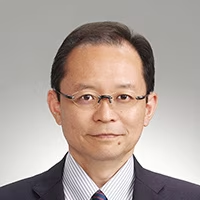
Taku Umebayashi
Dept.7
Research Div.1
Sony Semiconductor
Solutions Corporation
Contributed significantly to the development of the stacked CMOS image sensor with multiple functions. Awarded the Medal with Purple Ribbon in spring 2020 for his achievements. -

Albert Tumewu
Automotive Design Dept.
Automotive Business Division
Sony Semiconductor
Solutions Corporation
Joined the company in 2009. Performs design work for signal processing blocks. After designing image processing blocks for televisions and surveillance cameras, he was put in charge of developing automotive image sensors in 2015. -

Makoto Aoki
Automotive Development Dept.
Automotive Business Division
Sony Semiconductor
Solutions Corporation
Joined the company in 2007. Performs design work for analog circuits. After designing products for cameras and mobile devices, he was put in charge of developing automotive image sensors in 2015.
The stacked CMOS image sensor is a highly versatile platform
──Please tell us about the merits of the stacked CMOS image sensor and the value that stacked technology has brought to the semiconductor industry and society.
Taku Umebayashi:The stacked type is a structure that can be used for a wide range of image sensors. It allows you to select functionality based on needs, such as speed, multi functionality, low power consumption, and low cost. This gives you more options when developing a product, so in terms of versatility, I think the stacked CMOS image sensor is closer to a platform.
Terushi Shimizu:The stacked CMOS image sensor has made things more convenient for camera users all over the world. For example, Sony’s share of the mobile image sensor market is over 50%, and I believe that the significant progress in smartphone camera performance is due to this stacked technology. Stacked technology has contributed to higher quality photos in the imaging field and provided many people with kando experiences. It is these achievements that led to Umebayashi-san receiving the Medal with Purple Ribbon in the spring of 2020.
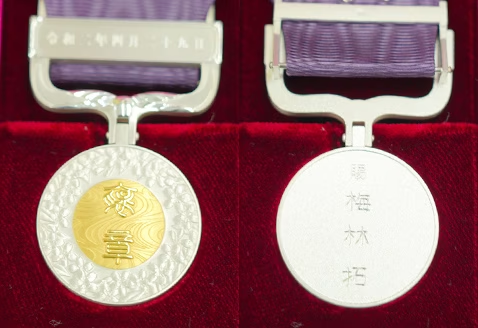
The front (left) and back (right) of the Medal with Purple Ribbon
Contributing to society and realizing safety and security
──The I&SS business’ technological advancements contribute not only to Sony Group profits but also to society. What kind of social contributions would you like to achieve in the future through imaging and sensing technology?
Shimizu:Based on Sony’s Purpose and Values, the Sony Semiconductor Solutions (SSS) Group’s mission was redefined and it now "To spark imaginations and enrich society through the power of technology." SSS is aiming to have the largest share of the imaging and sensing markets in the world. Through imaging and sensing technology, we would like to support people, realize safety and security, and contribute to society. Additionally, with automobiles moving closer to full automation, the development of automotive image sensors is one of SSS’s most important initiatives to contribute to society.

Makoto Aoki:Automotive image sensors need to be able to see in situations that the human eye cannot, such as when exiting a dark tunnel into bright light or driving on a dark road at night. This is where we take advantage of one of the great strengths of Sony’s image sensors: pixel and circuit design technologies that achieve high image quality. Image sensors for cameras need to be able to capture an image exactly as the human eye sees it so, in 2007, image sensors with a column A/D conversion circuit were commercialized to improve image quality. This technology, which is capable of taking beautiful pictures even in dark places with low noise, was adapted to expand the dynamic range (brightness range for image recognition) for automotive image sensors. In this way, the know-how and assets cultivated by the I&SS business, including stacked technology, is being used to develop automotive image sensors.
Albert Tumewu:In addition to Sony’s wide range of assets, communication and brainstorming with other departments and feedback from customers has also greatly advanced development.
Shimizu:I definitely think that the presence of SSS automotive image sensors is increasing. As employees involved in the development, how do you feel?
Aoki:When we explain our products to customers like car manufacturers, we sometimes receive requests not only for demonstrations but also for specific customization options. I’m really happy that we are getting this kind of reaction to the products that we developed.
Tumewu:It is also very rewarding to see the products that we developed mentioned in the news. It moves me to know that these products are contributing to society, just like the SSS mission says.
Shimizu:In addition to automotive image sensors, we can also expect to contribute to society through intelligent vision sensors with AI processing functionality, another product developed with stacked technology. The AI processing functionality allows for the development of smart cameras that we expect will be taken up in the retail and industrial equipment industries. For example, in retail, these cameras could count the number of customers entering a store, detect missing items on shelves, and create heat maps to determine where people gather. These applications would allow owners to analyze the behavior of customers in their stores. In the industrial equipment industry, they could be used for danger alarms, detecting intruders, and handling dangerous materials. We also think that these sensors will be increasingly used to confirm whether people are wearing masks, thereby helping to prevent infections.
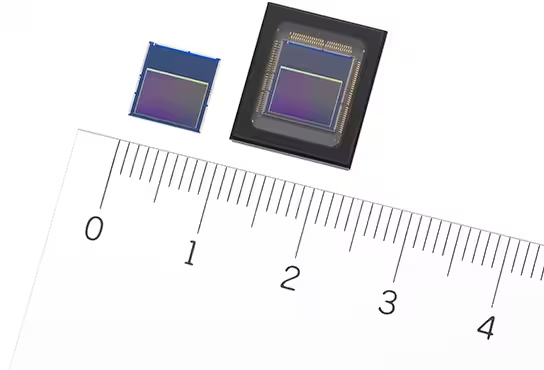
Intelligent vision sensors / (Left) IMX500, (Right) IMX501
Sony’s culture and values provide a tailwind for development
──Why was Sony able to develop the world’s first stacked image sensor?
Umebayashi:There were two main reasons. The first is the compatibility of the manufacturing process with the back-illuminated CMOS image sensor released in 2009. Back illumination is a technology that realizes high sensitivity and low noise by illuminating the backside of the silicon substrate. However, the silicon substrate needs to be very thin for this to work, so we use a laminating technique to join the chip to a support substrate to maintain durability. Now, while the stacked type uses different techniques, we were able to apply some of the same principles, thus moving the development along more quickly. The second reason was a focused purpose. In the semiconductor industry, there was a trend of making ultra-multifunctional products by stacking various types of chips. However, we didn’t follow this trend. Instead of trying to pack in as many functions as possible, we made a smaller product with performance comparable to conventional image sensors.
Tumewu:So that’s what happened. During development, I often wanted to add in as many functions as possible, so the idea of going against that was very interesting.
Aoki:When you are faced with a difficult problem, how did you go about solving it?
Umebayashi:I value issue recognition and cross-cultural exchange. When I have a problem, I try talking to people in different fields and consider whether I can apply a technology or way of thinking that seems unrelated at first glance. Then, I slowly and methodically brush up on each of the issues.
Shimizu:I think the reason Sony was able to develop stacked technology lies in the challenger spirit that has been passed down until now. Sony’s culture encourages "doing what nobody else can." Even if you don’t get results, people respect that challenger spirit.
Aoki:Yes, even with high-risk projects, our supervisors often say things like, "Give it a shot!" or "We can gain experience." These remarks are very encouraging from a development standpoint.
Tumewu:When I was involved in signal processing, the development schedule changed a number of times due to various issues, but the people around me responded flexibly.
Shimizu:We tell young employees in particular to "always be sincere." You should convey your thoughts to everyone with a sincere attitude.
Umebayashi:Sony has always had a culture of treating people equally, regardless of their job title. This corporate culture makes it easier to convey your thoughts to others.
──Please tell us about the future outlook for the I&SS business.
Shimizu:We’re thinking about our hardware and software strategies together. In addition to selling hardware—our sensors—we also plan to expand sales of services incorporating software. In terms of software strategy, we will focus on solutions that combine devices with edge AI, such as our intelligent vision sensors. We are also collaborating on smart camera solutions with Microsoft, with the goal of establishing a more advanced sensing solutions business by linking their cloud AI services with our edge AI. I believe that imaging and sensing technology can move people and contribute to a safer society. I hope that everyone involved with development will work with pride, knowing that what they are doing will benefit society.
Umebayashi:We want to combine software and hardware to produce a system and provide new value to society. Under the mission of SSS, "To spark imaginations and enrich society through the power of technology," I would like to continue developing new technologies while considering their social significance.




